High-end LCD televisions from Samsung have been superb in the past, and this year it’s no different. Samsung have redesigned the GUI for better user interaction, updated the design and implemented new video processors. So without further ado, let’s move on to our Samsung LE46B750 review.
<!-- google_ad_client = 'pub-2887677957235196'; google_ad_slot = '4990177225'; google_ad_width = 336; google_ad_height = 280; //-->
Note: The specific model we tested was the Samsung LE46B750U1W, which may be sold as LE46B750, LE46B750U or LE46B750U1 by high-street stores like John Lewis, Comet and Currys, or online retailers such as Amazon or Dixons. While we did not test the 40-inch LE40B750, there is no reason to believe that there will be any drastic difference in picture performance.
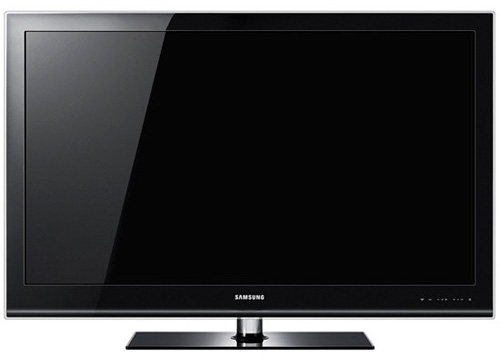
The design of the Samsung LE46B750 HDTV is simple yet elegant. The piano-black finish with reflective panel will complement any living room. The build quality has improved significantly this year. The panel no longer appears to be composed entirely out of plastic. Also, unlike on the previous models, the input and output ports are solid and no longer bend/warp when plugging cables into the HDMI or the SCART connections. Overall, I’m quite impressed and prefer the conservative design chosen by Samsung.
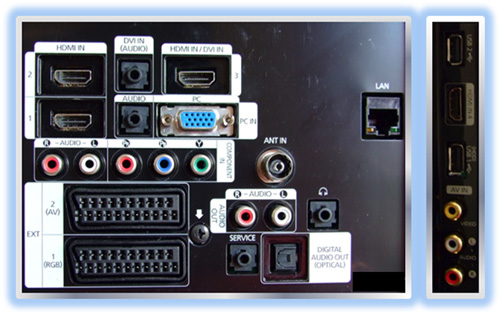
The Samsung LE46B750 LCD TV features 4X HDMI (v1.3), 1X D-Sub, 2X 3.5mm audio jacks (for D-Sub and DVI), 1X Component Video, 1X Optical Out, 1X Ethernet, 1X Analogue Audio Out (RCA), 1X Composite, 2X USB, 1X Common Interface, 1X Standard SCART, 1X RGB SCART and 1X ANT In.
Samsung has resigned the old GUI and improved it many ways. It is now easier to navigate, and provides information regarding each function, which is a real treat for nervous users. It also provides all the necessary picture adjustment options to maximise the television’s performance without being forced to access the service menu. However, disabling the auto-dimming function does require the help of the service menu, but it’s not recommended as it may void the warranty.
 |
| Each function within the user menu is described with a caption |
Navigating between different inputs is a real delight although it could be more responsive/ faster. The menu system highlights connected and active devices, so you won’t have to guess blindly.
On the negative side, the GUI utilises most of the screen, which can be frustrating when calibrating. The animation of the GUI is not as smooth as I expected. The resolution of the GUI is rendered at a lower resolution and up-sampled, which does show.
_Side Note: Due to limited time and lack of resources, I was unable to fully test the Samsung LE46B750’s ‘additional’ functionalities such as DLNA, Widgets, Media Player etc… please refer to the relevant sections in the LE40B650 review if necessary.
_
When it comes to remotes, I always compare them to Sony, Pioneer and Matsushita (Panasonic), primarily due to the design, layout, ergonomics and functionality.

The design of the Samsung LE46B750’s remote control (BN59-00861A) is aesthetically pleasing. However, it does lack the lavishness of high-end models. The layout is close to excellent and the backlight function is the icing on the cake. I would have chosen a different font, but it does the job.
The buttons do feel somewhat ‘cheap’, but in this day and age, it shouldn’t be a problem as most rarely use the TV remote.
Like most high-end sets, the Samsung LE46B750 LCD HDTV comes with greyscale calibration options as standard, which allow users to maximise the set’s performance.
Unfortunately, it’s virtually impossible for a consumer grade display to produce uniform gamma, colour and luminance across the screen. The panel embedded on our review sample is no different. Upon displaying a shade of dark grey (20IRE), I could effortlessly detect colour variations across the screen. More information on this matter can be found under the “Uniformity” section in this article.
The results below were obtained by performing the measurements at the centre of the screen:
 |
| Pre-calibration “Warm 2” CCT |
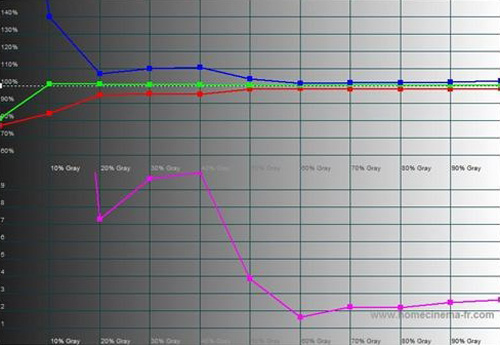 |
| Pre-calibration “Warm 2” RGB tracking |
As you can see from the images above, the RGB value stabilised after 50IRE. This preset value is better than most sets.
 |
| Post-calibration “Warm 2” CCT |
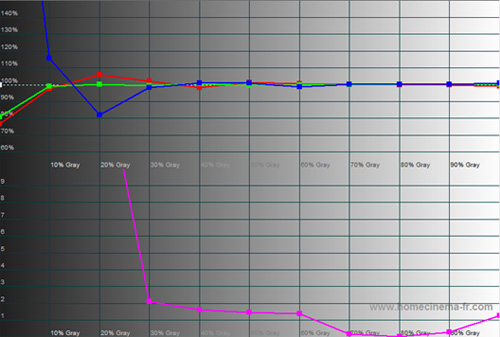 |
| Post-calibration “Warm 2” RGB tracking |
After altering the RGB Gain and RGB Offset, I managed to obtain a fairly accurate image.
 |
| Post-calibration “Warm 2” gamma |
This was truly a pleasant surprise. The gamma managed to maintain within 2.2.
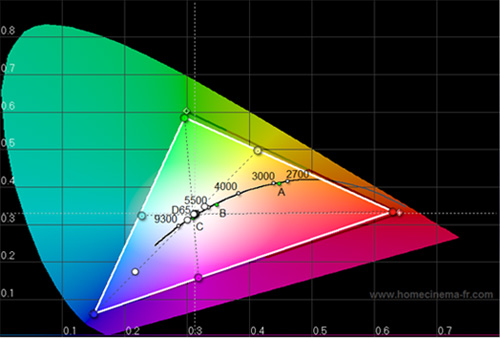 |
| Post-calibration CIE chart with reference to HD Rec.709 specifications |
With [Colour Space] set to “Auto“, the Samsung LE46B750 HDTV managed to produce very decent chromaticities.
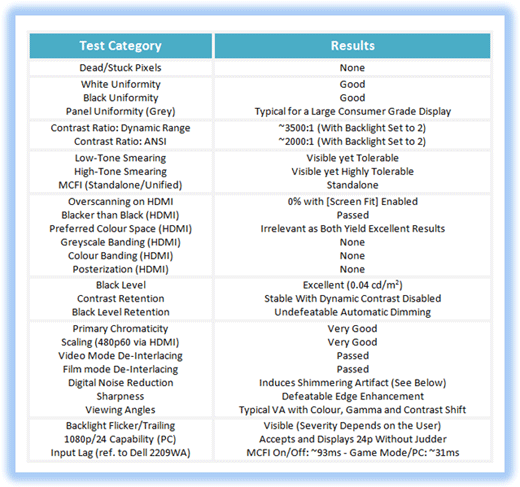
| Factory [Dynamic] mode | ~221 watts |
| Calibrated [Movie] mode | ~105 watts |
| Standby | <1 watt |
The panel on our Samsung LE46B750 test model yielded good black and white uniformity corner to corner. Backlight bleeding in real-life was barely noticeable and the panel uniformity was typical for a consumer grade display. By that I meant there were visible defect and imperfections across the panel, but nothing too distracting. However, it did make it slightly more difficult to accurately calibrate the display as our measuring device will only register values from a single location.
In fairness, it’s virtually impossible for manufacturers to produce a clean panel with cost in mind, and other technologies such as plasma and CRT also suffer from similar issues.
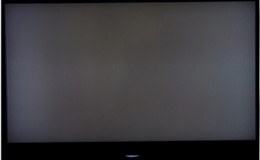 | 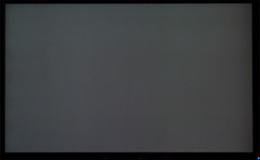 |
| Samsung LE46B750 uniformity | Dell 2209WA uniformity |
Again, the main problem with such flaws is getting calibration accurate. But on a consumer-grade television, it shouldn’t matter too much.
With [Backlight] value set to 2, the Samsung LE46B750 produced an excellent dynamic range of 3500:1 on-off and 2000:1 ANSI. The important value here is ANSI as ~99% of all contents are composed of dark and light elements. So at any given moment, the Samsung LE46B750 can generate 2000:1 without a problem, which is a big plus.
I found the auto dimming on the Samsung LE46B750 rather effective in delivering plasma level blacks without degrading the image to a point where it becomes noticeable. Also, the auto dimming only kicks in if the panel is prominently black. For the record, I failed notice the fluctuations in black level while viewing videos and playing games.
Pixel Response: With my usual tests based on PixPerAn, I was able to detect visible low and high tone smearing caused by overdrive errors. Sadly, this phenomenon is neither new nor localised to the Samsung LE46B750 as it affects number of HDTVs and monitors (based on VA/TN technology). I simply fail to understand manufacturers’ undying quest for overdriving the pixels without perfecting overdrive mechanism. Thankfully on this occasion, the effect on real world content is negligible.
For reference, my two year old Sony BRAVIA KDL-26P2530, (which is fitted with PVA panel) has no form of detectable smearing.
MCFI: Samsung’s implementation of MCFI was rather average in comparison to other manufacturers (namely Panasonic), and the improvement in motion can only be ascertained by sacrificing image quality/ stability. In other words, as the value of [Blur Reduction] increases, the level of visible artifacts begins to creep in. However, on highly compressed sources such as Sky HD, DVB-T etc…, artifacting becomes less noticeable.
After updating the firmware on our Samsung LE46B750 review unit to 2009/04/14_001008, there was a noticeable improvement in 200Hz processing. Setting the value of the [Blur Reduction] to “5” produced fewer visible artifacts than with the previous firmware. Nevertheless, we recommend that you only enable the 200Hz when viewing sports.
On a brighter note, Samsung did not unify high-level and low-level MCFI. Instead, they provide users with the option to manually control the intensity of the MCFI, which is a must-have on all sets with MCFI.
Samsung LCDs were never known for their audio performance. They have always been criticised for having poor audio and the B750 is no different. The Samsung LE46B750 sounded like a pair of cheap speakers with no real detail in any of the frequencies.
I wish Samsung would include a detachable speaker with decent sound, or at least sell it as an optional accessory. That way, people aren’t forced to spend extra on a sound system.
I am extremely impressed by the Samsung LE46B750’s picture performance. The image it produced was extremely clean and free of all common image artifacts. Transitions between different shades of colours were smooth with no visible banding or posterization. I also failed to detect any form of black or white crush. So far, I have only seen these positive attributes on monitors. However, the image produced by the Dell 2209WA remains slightly superior (primary due to the fact it was automatically calibrated and has minute uniformity issue).
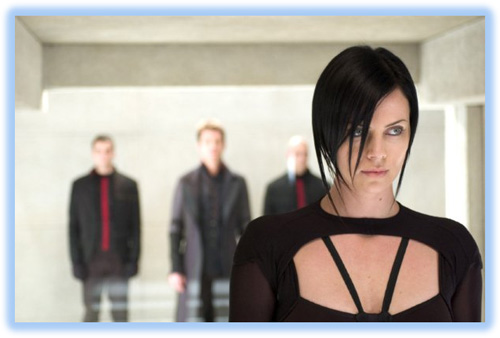
Skin tones are one of the most important aspects of image quality and the Samsung LE46B750 LCD television rendered it beautifully. The image had excellent detail, depth and clarity without any visible colour dominance. The variant shades of warm colours that encompass Charlize Theron’s face, neck and chest were clearly visible and truthful. There remained a hint of processing, but it’s very subtle and complemented the image.

This image will highlight any inaccuracies in colour, greyscale, black crush and gamma… and the Samsung LE46B750 aced it in every aspect. There wasn’t any evidence of black crush. The gamma was spot on and there wasn’t any detectable colour dominance. In fact, the image accuracy is comparable to the Dell 2209WA, but there were minor inaccuracies which is forgivable as it’s virtually impossible to calibrate a large-sized LCD panel uniformly across the screen (as stated before).

This is a beautiful image with multitude of colours which makes it ideal for direct comparison. As you can guess, the image produced by the Samsung LE46B750 LCD HDTV was outstanding and highly comparable to the calibrated Dell 2209WA. There were no signs of black or white crush, nor (visible) inaccuracies in colour. Also, the transitions between multitude shades of colours were smooth and free of artifacts. Simply put, the rendered image was simply spectacular.
Overscanning: Users can enable “Screen Fit” when using 1080i/p and 720p to disable over-scan. This is ideal for keeping scaling errors and loss of detail to a minimum.
Backlight Flicker/Trailing: Unfortunately, the Samsung LE46B750 suffers from backlight flicker and backlight trailing, but thankfully, only trailing is perceivable. These visual artifacts aren’t unique to Samsung as many LCDs suffer from them. One of the known causes is the CCFLs failing to receive enough power. On the Samsung LE46B750, setting the [Backlight] to “10” will cure the trailing, but it is not recommended due to obvious reasons.
Blacker than Black (HDMI): The Samsung LE46B750 accepts both VESA and CEA signals, so it’s compatible with Computer and Consumer Electronic Standards.
Viewing Angles: Unfortunately, the viewing angle of the Samsung LE46B750 was rather average. The viewer must sit directly in front of the TV with an average distance of 1.75-2 meters to avoid colour, gamma and contrast shifts.
High-def materials on the Samsung LE46B750 HDTV were superb. The deep blacks and stable gamma truly complemented the image. The performance of 24p was also excellent. Motion appeared smooth and sturdy… a joy to watch. The reflective panel helped to induce additional depth to the image, which was clearly visible when I viewed Finding Nemo. Words simply cannot express the image rendered by the Samsung LE46B750. Those who are venturing into the world of HD will be truly stunned by the picture quality without a doubt.
The Samsung LE46B750 LCD TV produced excellent results with minimal noise via RGB SCART. As with HD, there was no visible evidence of neither black nor white crush.
Scaling (480p via HDMI): The scaling algorithm used by Samsung LE46B750 is somewhat on par with the ATI HD4XXX series graphics cards. The ATI HD4650 produced excellent detail with noticeable colour errors where the Samsung produced slight distortion in fine detail with minimal colour errors.
Film and Video Mode De-Interlacing: Samsung LE46B750 LCD television did an excellent job of de-interlacing. The image was clean and free from aliasing, which is a must for large panels.
Digital Noise Reduction: Enabling noise reduction caused a shimmering effect, which can be perceived if viewed within 1.8 meters, so it’s best disable noise reduction.
Due to the high input lag, I cannot recommend the Samsung LE46B750 for hard-core gamers. However, for casual gamers, it’s just about acceptable with [Game Mode]/ [PC] mode enabled.
Enabling [Game Mode] considerably reduces the input lag, but it prevents users from selecting WARM 2, which is needed to get close to the D65 standard. Thankfully, this can be overcome by connecting the console to HDMI 3 (HDMI/DVI) and assigning the name “PC” via Name Edit.
Press the Menu button the remote > scroll down and select Input > select Edit Name > scroll up/down to select HDMI3/DVI and set it to PC.
Be advised that in [PC] and [Game Mode], MCFI (200/240Hz) cannot be enabled as the panel reverts to 60Hz, which may affect those who are highly sensitive to motion blur.
Samsung did a wonderful job with the LE46B750. Apart from the average MCFI performance and high input lag, the Samsung LE46B750 is truly one of the best 46-inch LCD HDTV on the UK market.
Hopefully, Samsung will continue to improve their MCFI algorithm (as they have been known to in the past), so keep an eye out for those firmware updates.

The following configurations are unique to the test model, and are to be used as reference only:
 |  |
 |  |
 |  |
 |  |
 |  |
 |  |
 |  |
 |  |
 |  |
 |  |
 |  |
 |  |
 |  |
 |  |
 |  |
 |  |
 |  |
 |  |
 |  |
 |  |
 |  |
 |  |
 |  |
 |  |
 |  |
 |  |
 |  |
 |  |
 |  |
 |  |
 |  |
 |  |
 |  |
 |  |
 |  |
 |  |
 |  |
 |  |
 |  |
 |  |
 |  |
 |  |
 |  |
 |  |
 |  |
 |  |
 |  |
 |  |
 |  |
 |  |
<!-- google_ad_client = 'pub-2887677957235196'; google_ad_slot = '0693194791'; google_ad_width = 336; google_ad_height = 280; //-->